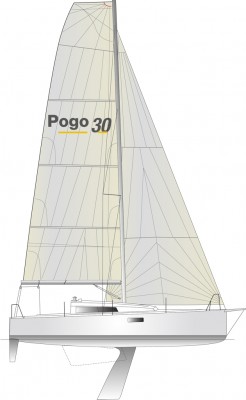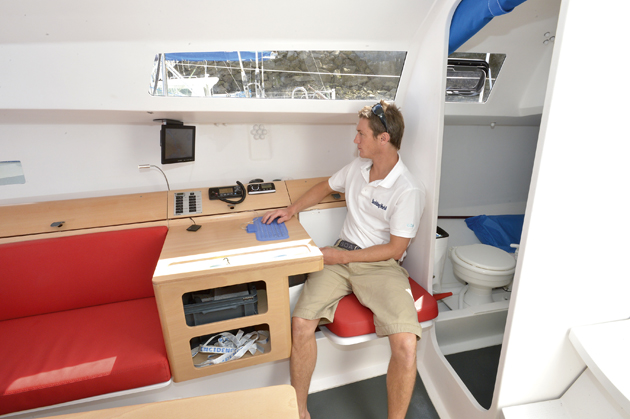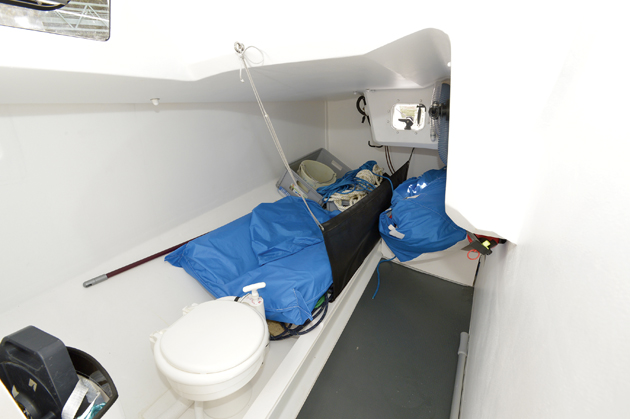Is the Pogo 30 the most fun you can have in a cruising 30-footer? Very probably, says Toby Hodges after an exhilarating romp off Brittany, so long as creature comforts are not uppermost in your priorities
Pogo 30 on test – pocket performer with cruising aspirations
Cruising dinghy
The Pogo is a lightweight boat. Her thin, light sheets and halyards can mostly be tightened by hand, which makes for easy, manageable sailing. You can see instantly that the yard is used to building boats for short-handed racing, so ergonomically designed is the cockpit. Winches are well located on the coachroof, so can be wound comfortably while standing up rather than requiring you to lean over a leeward rail. Kite gybes proved a doddle.
Sailing the Pogo is rather like being on a big dinghy. She’s very sensitive to sail trim, especially with the optional carbon mast, so the kicker and traveller are frequently used. Mounted across the transom, the latter benefits from the maximum beam and is your best friend to tame a square-topped main like that of a multihull. The traveller leads were impractical for the helmsman to operate, however. These have since been redesigned and swivelling camcleats now help make things neater and easier.
The tillers seemed comfortable in my hand. It turns out they are made from the same material as windsurfer booms for optimal grip in the wet. They also lift vertically to keep the cockpit clear. Optional tiller extensions allow the helmsman to sit out or go forward to reach the winches.
If you can tear yourself away from the helm, the Pogo is a safe, secure boat to get around. There is excellent non-slip everywhere, including on the angled coachroof.
Just when I thought we had had more than our share of sailing pleasure off the coast, another treat lay in store. We short-tacked up the confines of the Odet river against a whistling ebb tide. The Pogo proved ultra-stiff and responsive, allowing me to work lifts like a dinghy. I simply didn’t want the experience to end.
Beam me down below
It would be easy to take a wholly positive or negative view of the Pogo’s interior. First the positive. The initial impression below is of overwhelming space for a 30-footer. Her emphatic beam buys you an enormous volume below decks, something which is further emphasised by the minimalist styling of the very basic, open interior.
And therein lies the negative. To love a Pogo you’d have to be happy with an utterly unfussy interior finish. Think nautical French camping: no doors, only small open lockers, a freestanding heads and minimal lighting and appliances. If you ask nicely there’s a stove and hot running water. So, while the 30 may still seem like sheer luxury to some racing sailors, it lacks the creature comforts many cruisers would expect.
That said, sleeping aboard during our test was comfortable enough and served to demonstrate that the full foam sandwich build cuts out any condensation worries.
But the Pogo is essentially a raceboat shell, with a bare gelcoat finish and no lining, so there’s little to insulate noises from on deck. Even raindrops announce themselves with a ‘plink, plink, plink’.
This wasn’t nearly enough to alter my feelings for the boat, though. If you include the 2m saloon sofas there are six berths, with an option of an extra bunk in the starboard aft cabin – not bad for a 30-footer. In its standard format, this starboard aft cabin is used as a heads that connects to a vast storage area.
Our test boat had the standard basic interior because the owner will largely be daysailing. So, there was no sink nor shower in the heads and in the galley was just a bucket seat with a camping hob instead of a proper stove. The ‘comfort’ version has galley and heads facilities. I would also add fabric lockers throughout.
Saloon: the 30 has a generous saloon with good natural light and views. The long table can neatly incorporate a hydraulic lifting-keel mechanism. The forward section of the table has leaves that open to seat four (or six if you’re good friends). Stowage is limited to space under the aft berths – I felt that the raised space outboard behind the berths could be better utilised.
Navstation: this features a simple, light, lifting composite seat with storage below. This bucket seat is very comfortable for sitting at the table (or reclining for a power nap) and the instrument space outboard is good. But the chart table would be improved with the addition of a lift-top to stow charts and other navigation gear.
Heads: this is located in an aft workspace behind a canvas door. Most clients opt for a sink and shower option. The stowage space aft is superb, with a canvas berth and leecloth for holding a dinghy, sails etc in place.
Galley: in two words: extremely basic. The test boat had the same type of bucket seat as the navstation in which to sit while brewing up on a camping stove. Stowage is basic and options include a cooker and fridge.
Cabins: both the aft port and forward vee are no-frills cabins with large double berths. Again, stowage is limited, so fabric wardrobes might be useful here. It’s a far cry from most production 30-footers.










